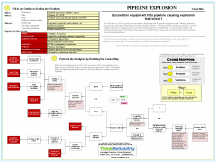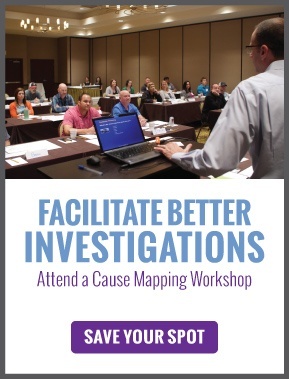 On October 31, 2016, a piece of excavation equipment hit a gasoline pipeline near Helena, Alabama, causing an explosion that killed one and injured 5 others. The equipment was being used for repairs related to a large leak found on the same pipeline in September (see our previous blog to learn more). The explosion itself was terrible enough, and the timing of this second incident threw more fuel on the current controversies surrounding pipelines.
On October 31, 2016, a piece of excavation equipment hit a gasoline pipeline near Helena, Alabama, causing an explosion that killed one and injured 5 others. The equipment was being used for repairs related to a large leak found on the same pipeline in September (see our previous blog to learn more). The explosion itself was terrible enough, and the timing of this second incident threw more fuel on the current controversies surrounding pipelines.
The details for this incident can be captured in a Cause Map. A Cause Map is an intuitive method for performing a root cause analysis that visually lays out the cause-and-effect relationships that contributed to an issue. To build a Cause Map, start at the impacts to one of the goals, such as safety, and ask “why” questions. So why did this explosion occur? This explosion occurred because there was a spark, likely from metal equipment hitting a metal pipeline and fuel because the gasoline pipeline was ruptured. The pipeline ruptured because excavation equipment hit the pipeline and the strength of the pipeline couldn’t withstand the force. There has been no information released about whether the pipeline was degraded or if the pipeline remained as strong as designed, but this is something the investigation would want to evaluate, especially considering that the pipeline is 53 years old. There has also been no specific information released about why the excavation equipment hit the pipeline, but it has been stated that the equipment was being used near the pipeline in order to remove a bypass that was used to facilitate flow of product while repairs were made on the portion of the pipeline that was found to be leaking in September. As more information becomes known, it can easily be incorporated into the Cause Map.
Once the investigation is complete, the final step in the Cause Mapping process is to use the causes to brainstorm solutions and then determine which ones should be implemented. By building a Cause Map and focusing on a network of all the causes rather than a single “root cause” the set of solutions that are considered is naturally larger and the solutions that are implemented are often better at effectively reducing the risk of a similar effect occurring in the future.
Click on the thumbnail above to view an initial Cause Map of this incident.











